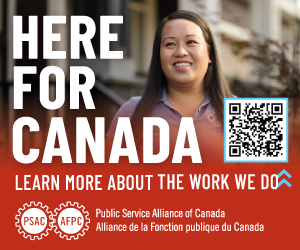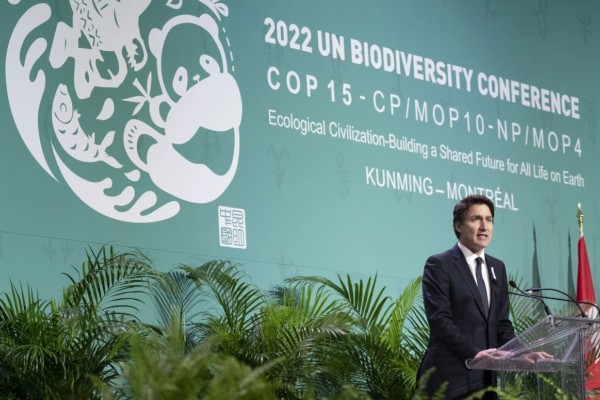Alberta tailings leak reveals the failures of Canada’s environmental assessment process
The disaster at Fort Chipewyan shows that decision-making around sensitive areas is still fundamentally rooted in development

An undated photo of the site of an overland spill at Imperial Oil’s Kearl Lake oil sands mining operation in northern Alberta. Photo courtesy Nick Vardy/Athabasca Chipewyan First Nation.
In the summer and fall of last year, mine waste from four tailing ponds at Alberta’s Kearl oil sands mining operation leaked around the community of Fort Chipewyan. The leakage lasted nine months. The disaster is one of the largest tailings leaks in Alberta’s history.
Nobody at Imperial Oil or the provincial government bothered to inform the Athabasca Chipewyan First Nation of the seepage. Instead, the company and the province’s regulators allowed locals to hunt and fish as they normally do, unknowingly exposing themselves to toxic waste products. It was only after Chief Allan Adam received a call from a neighbouring First Nation that he learned about the leaks—despite that fact that he had met with company officials three times since the seepage had started.
In an interview with the Guardian, Adam said, “[Imperial Oil and the Alberta government] were caught red-handed. The trust is gone. There’s no way you can come back from that. And we’ll always have what happened in the back of our mind, whenever we’re out on the land.”
Imperial Oil has stated that it doesn’t know how much toxic tailings waste has leaked into the land and water. The nation’s elders have advised community members to throw away all game and fish caught within the last nine months.
Adam has stated that the contamination of the community’s resources is not only a breach of the agreement the company signed with the nation, it is also a violation of their treaty rights, since they are now unable to harvest game and fish from their lands.
The Kearl oil sands project was approved in June 2008, with government authorities stating that Imperial’s activities were “not likely to cause significant adverse environmental effects.” An environmental assessment report, written by a joint panel established by Alberta’s Energy and Utilities Board and the Government of Canada in February 2007, had presented Canadian authorities with this conclusion. On water pollution, the report notes:
Imperial Oil stated that human health effects were predicted to be negligible for exposures to water from Wapasu Creek, the Muskeg River (and for fish), Kearl Lake, the portion of the Firebag River associated with the three tributaries north of the external tailings area, the Athabasca River, and the EPLs at closure and in the far-future for the project case.
The joint panel accepted the view of Imperial Oil, the province, and the federal government that the project would not endanger the health of locals: “The Joint Panel accepts Alberta’s and Canada’s views that the conclusions of the health risk assessment conducted by Imperial Oil are reasonable and believes that the KOS Project should not pose any significant health risks.”
Subsequent analyses of the joint panel’s report have concluded that the voices and concerns of locals were marginalized in the assessment process. In her analysis of the report, University of Ottawa professor Nathalie J. Chalifour argued, “While members of the community participated in the environmental assessment process, the resulting report suggests that their perspectives were granted little weight and had little influence on the Panel relative to the economic interests at stake.”
This marginalization, she posits, is embedded in Canada’s environmental review process itself, which has historically put more weight on development than local protections.
Before the environmental assessment was undertaken, members of the Fort Chipewyan community had made their concerns about environmental contamination very clear. Prior to the approval of the Kearl oil sands project, local fishermen were reporting that there were fewer fish in their waters and their nets came back covered in an “oily black film.” In May 2008, local Ray Ladouceur said, “I think our main killer here is our water. That’s what I’ve been trying to tell these reporters… It’s too much chemicals in our water, too much garbage in our water… Sure it’s nice to have money, but who are you destroying down below?”
For years before the joint panel’s report, Fort Chipewyan residents expressed concerns over environmental contamination and the disproportionately high rates of cancer in their community. In 2006, half of those who passed away at Fort Chipewyan died from cancer. One resident said, “it used to be that we buried our old people, but now we’re burying the young.” Local interviewees blamed industrial contamination of the community’s land, air, and water supplies for the high cancer rates.
The government’s assessments of health conditions at Fort Chipewyan were based on inadequate data. Most refused to link illnesses in the community to industrial causes, effectively informing locals that their health concerns were groundless.
A joint review panel for an earlier oil sands development stated that health data on Indigenous communities in the area was lacking and that the government should “consider undertaking a regional health study primarily dealing with First Nations, Métis, and other aboriginal people.” Despite acknowledging this dearth of essential data, the panel concluded that the oil sands project posed no significant health risks. The health study was not conducted.
Since members of the Athabasca Chipewyan First Nation learned of the tailings seepage, they have demanded answers from Imperial Oil and action from the Canadian government. Environmental Minister Steven Guilbeault has stated he is “deeply concerned” about the leaks, while Alberta’s regulator offered an apology to the community for failing to notify them of the tremendous risks to their health.
“I told them don’t bother apologizing,” said Adam. “We’re well past that. Fix this problem, and show me how you won’t let it happen again.”
"if this keeps up, we are probably going to be the first oil sands environmental refugees" says Mike Mercredi. Imperial Oil met with residents at Fort Chipewyan over the massive tailings pond leak that was kept hidden from the community it was poisoning https://t.co/wHSyxpqQC4
— Kate Beaton (@beatonna) March 25, 2023
The disaster at Fort Chipewyan, and the failure of Imperial Oil and the provincial government to notify locals, point to deeper inadequacies in Canada’s environmental assessment process. A consultation process that genuinely incorporates the concerns of those who are most impacted by industrial accidents would not have allowed such a disaster to occur. Likewise, any meaningful compliance oversight would have noted failings in Imperial Oil’s waste storage and corrected them.
Even as Canada has shifted toward an assessment procedure rooted in the language of “sustainability,” little has changed. Decision-making around environmentally sensitive areas is still fundamentally rooted in development, meaning that economically significant projects win out over the concerns of local communities.
Some have noted that recent changes in the environmental assessment procedure are largely toothless. References to treaty rights use the language of “consideration” for these constitutional rights rather than strict enforcement. Additionally, there is next to no compliance enforcement on projects such as the Kearl oil sands (Canada’s assessment agency did not even establish an enforcement branch until 2017).
If Canada wants to build a truly sustainable economy, the federal and provincial governments must implement meaningful consultation measures, respect constitutional treaty rights, and ensure that companies comply with their environmental commitments. Without these changes, any Canadian move toward “sustainability” will occur at the level of branding, not action.
Owen Schalk is a writer from Manitoba. His book on Canada’s role in the war in Afghanistan will be released by Lorimer later this year. To see more of his work, visit www.owenschalk.com.










